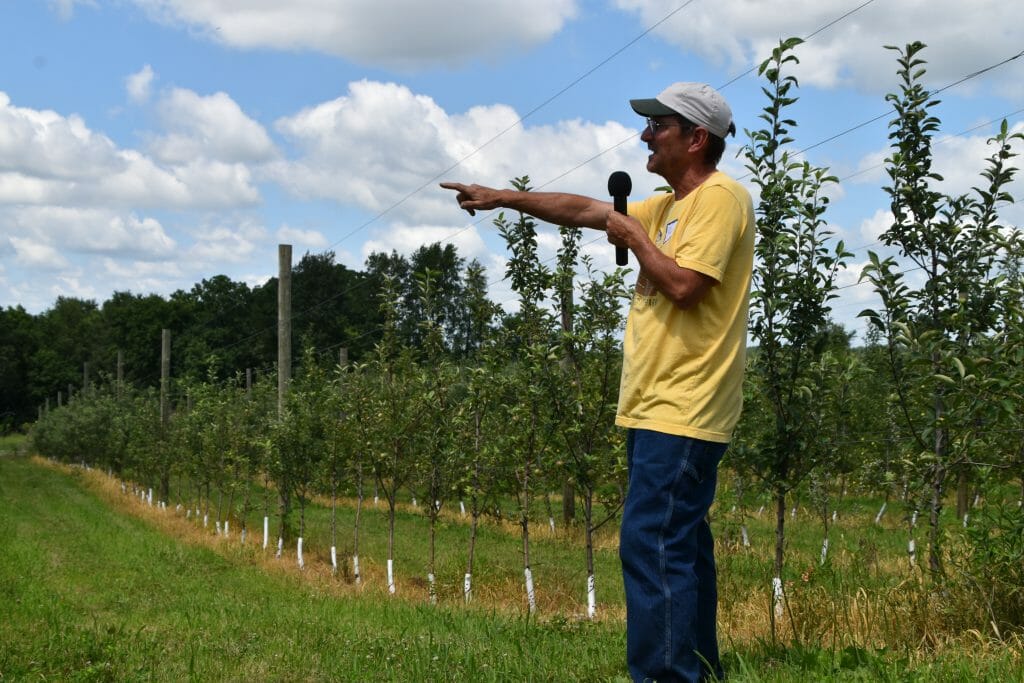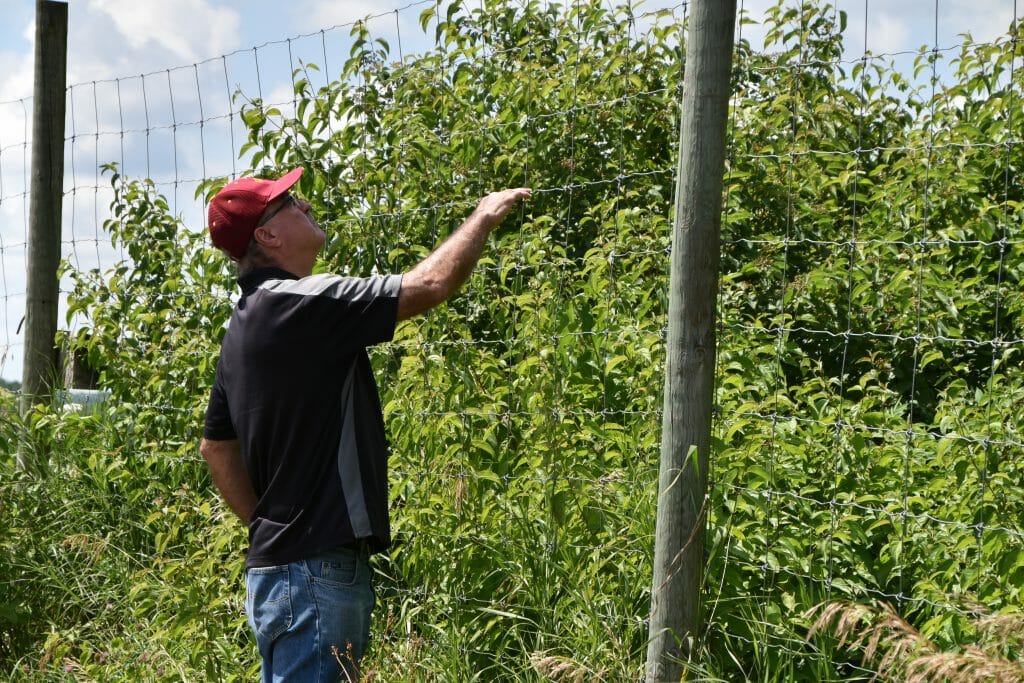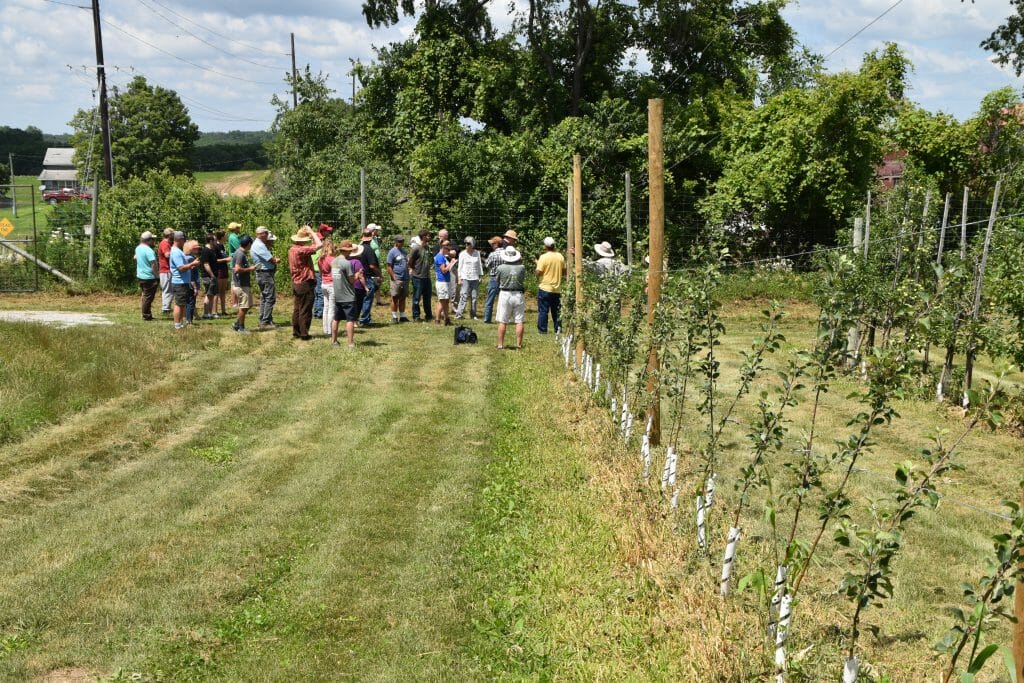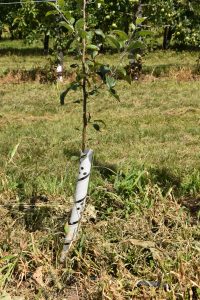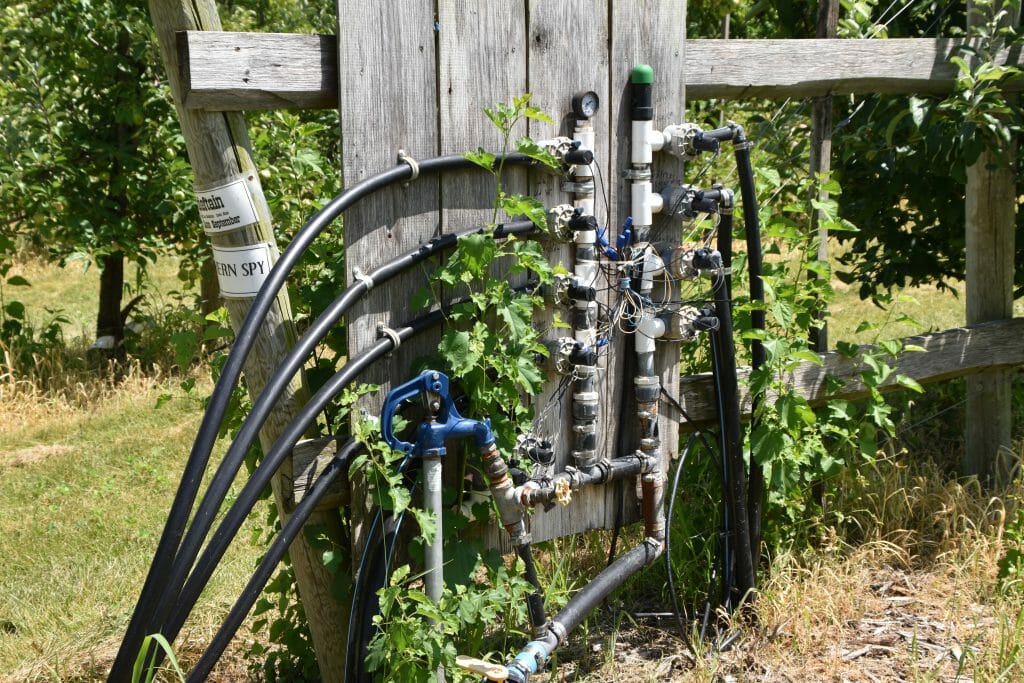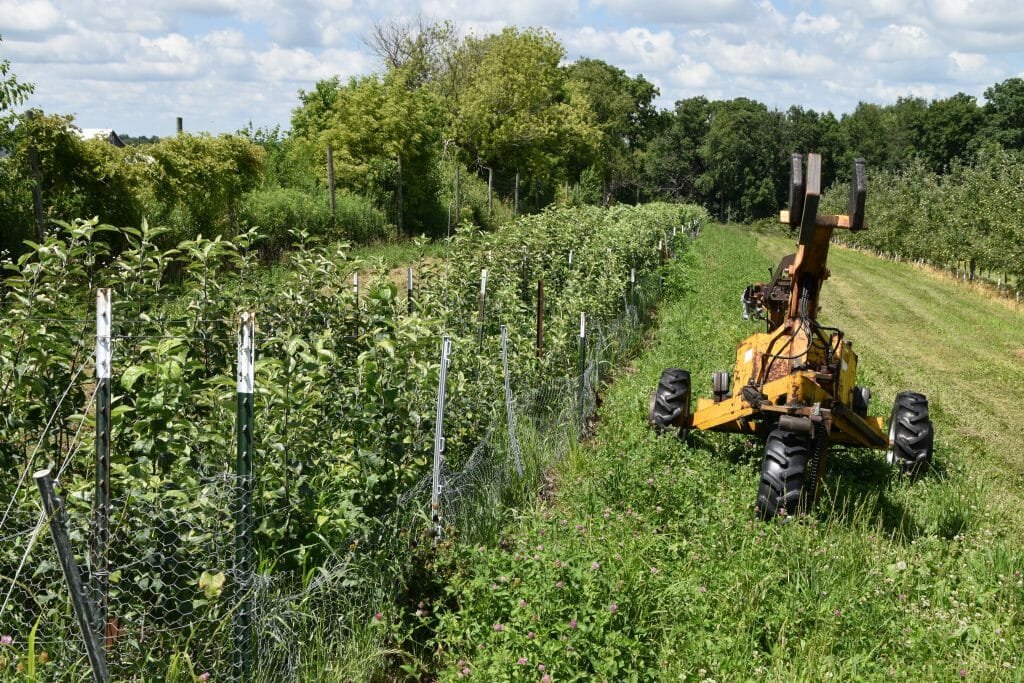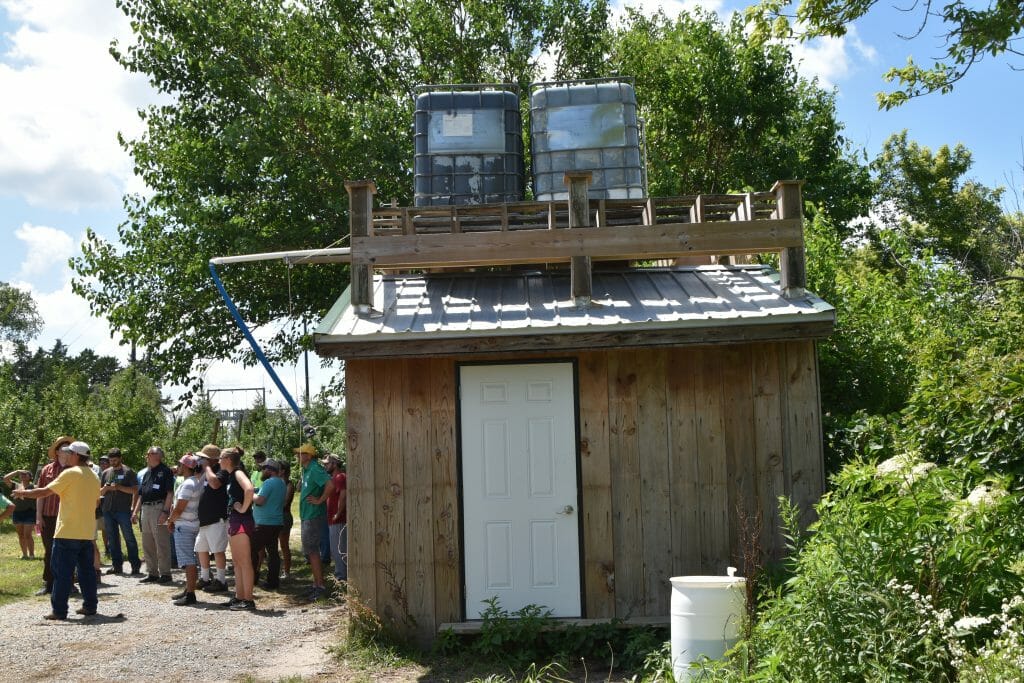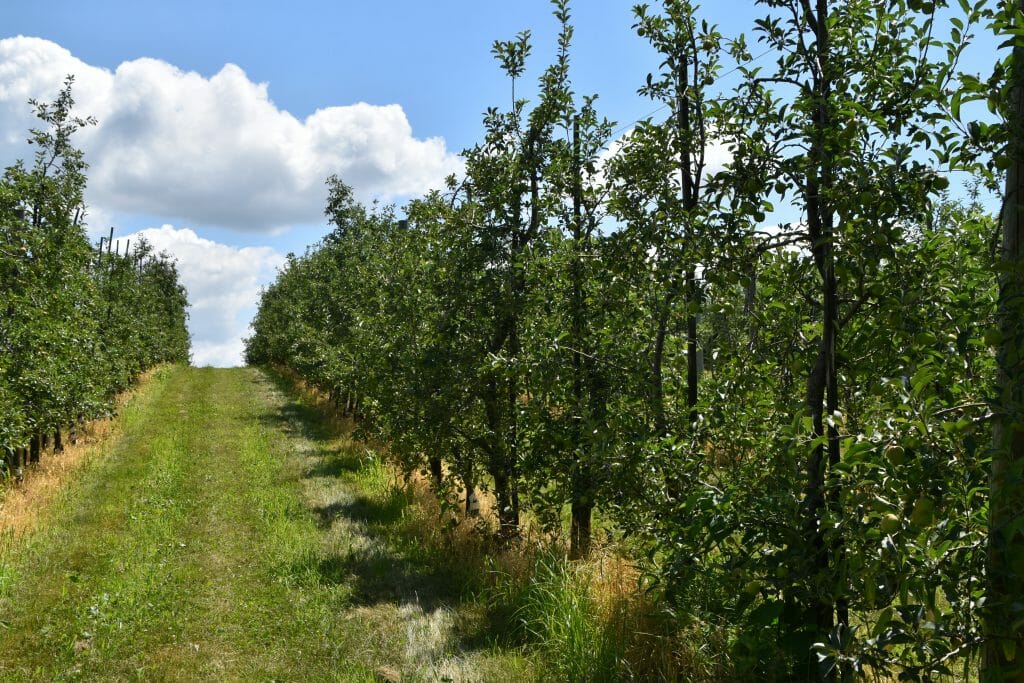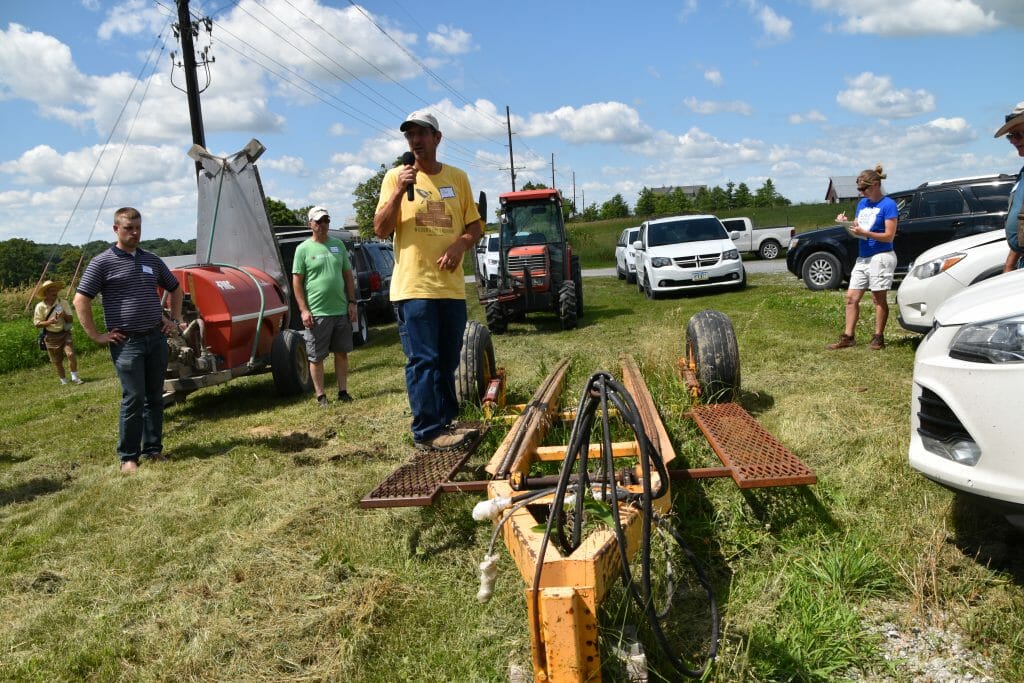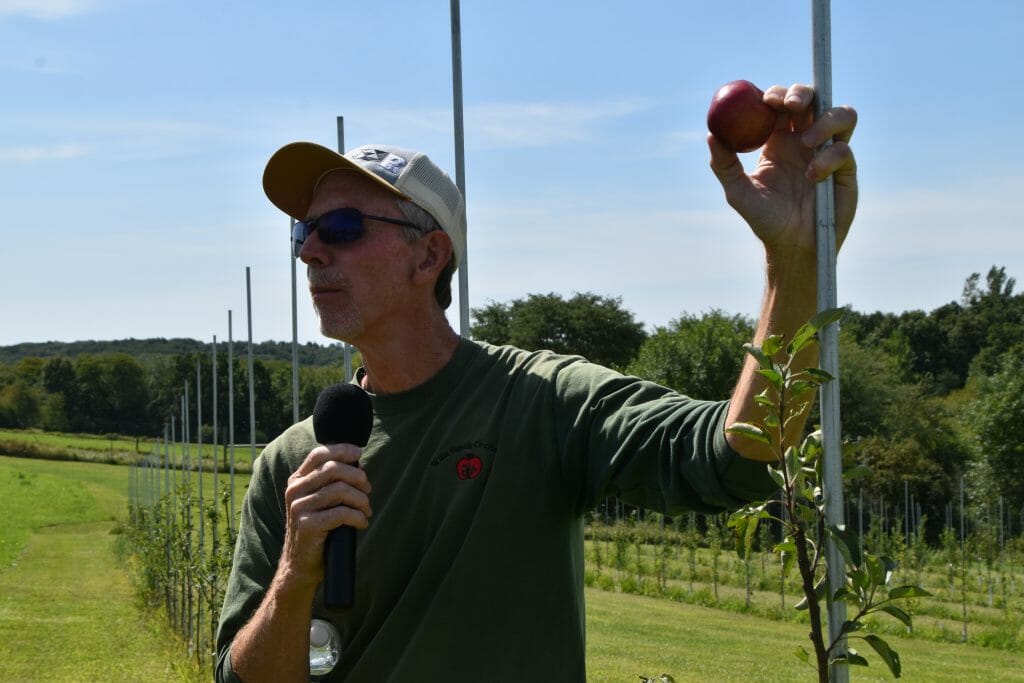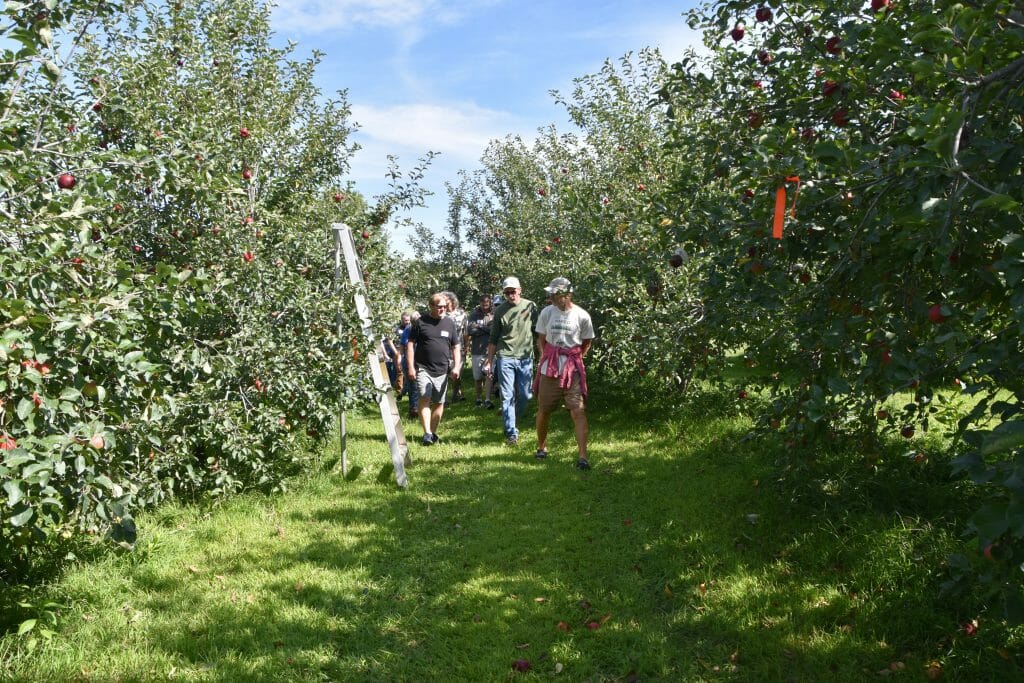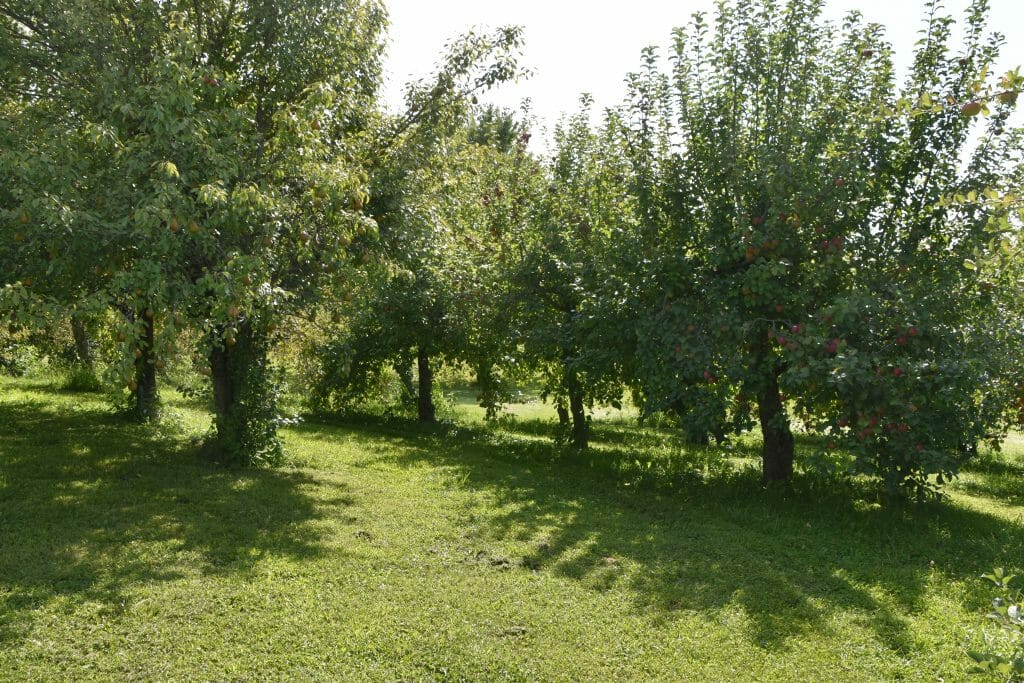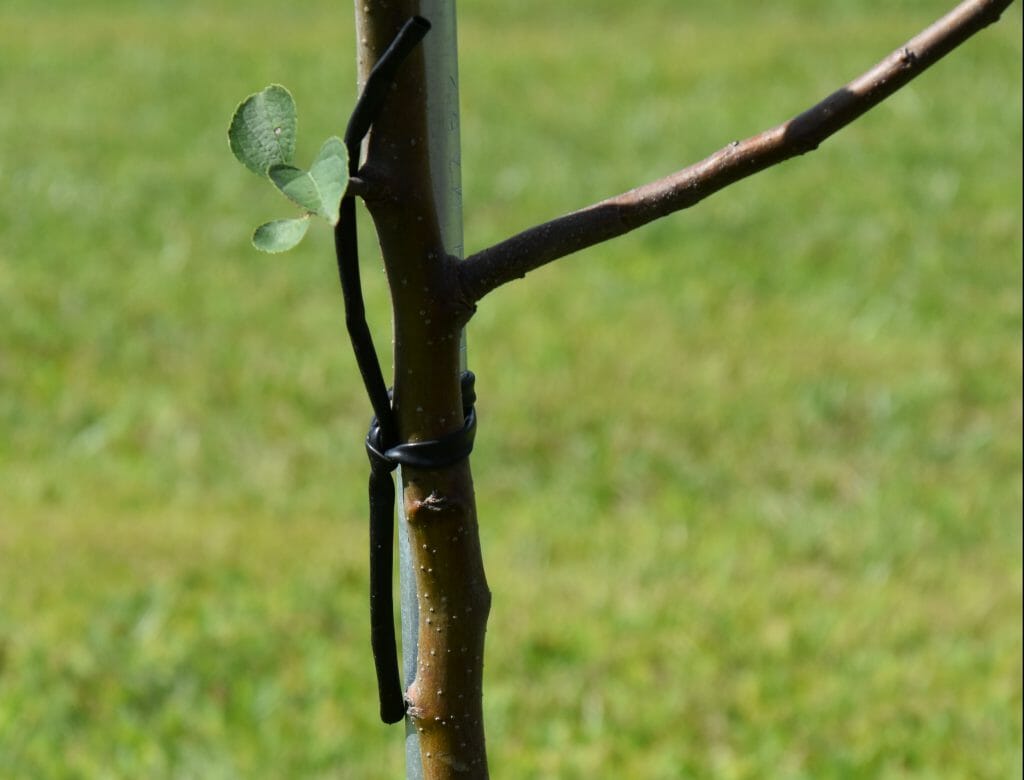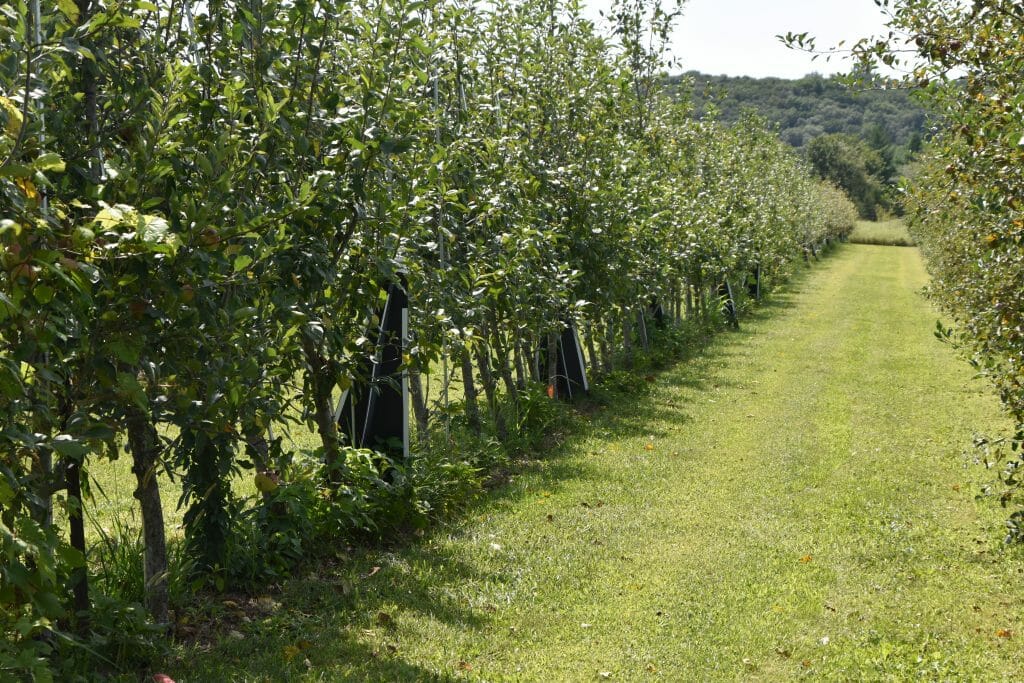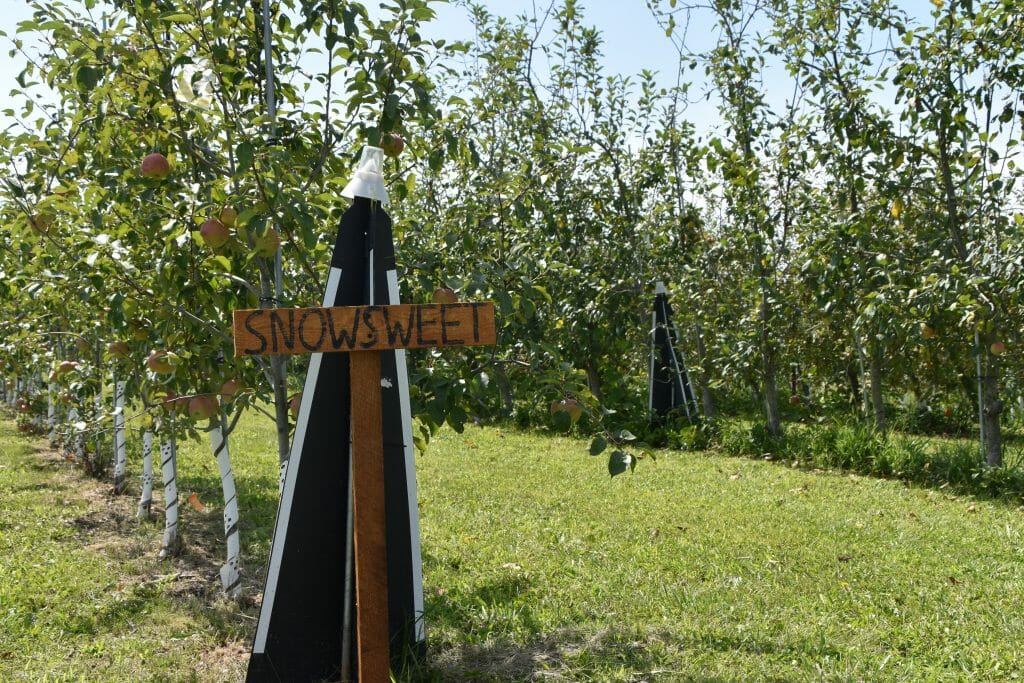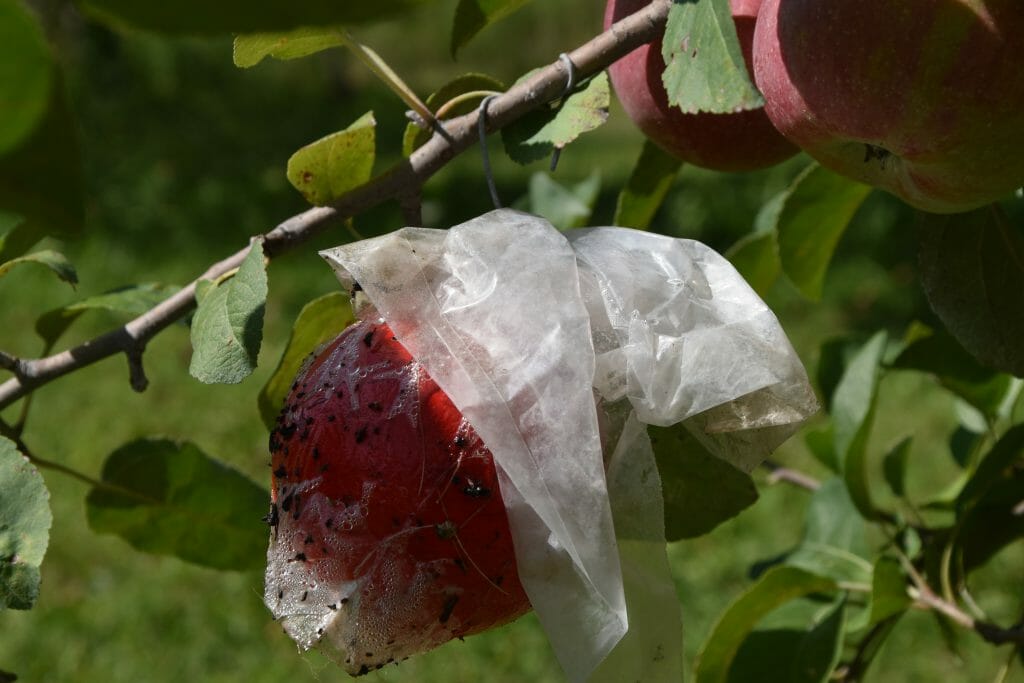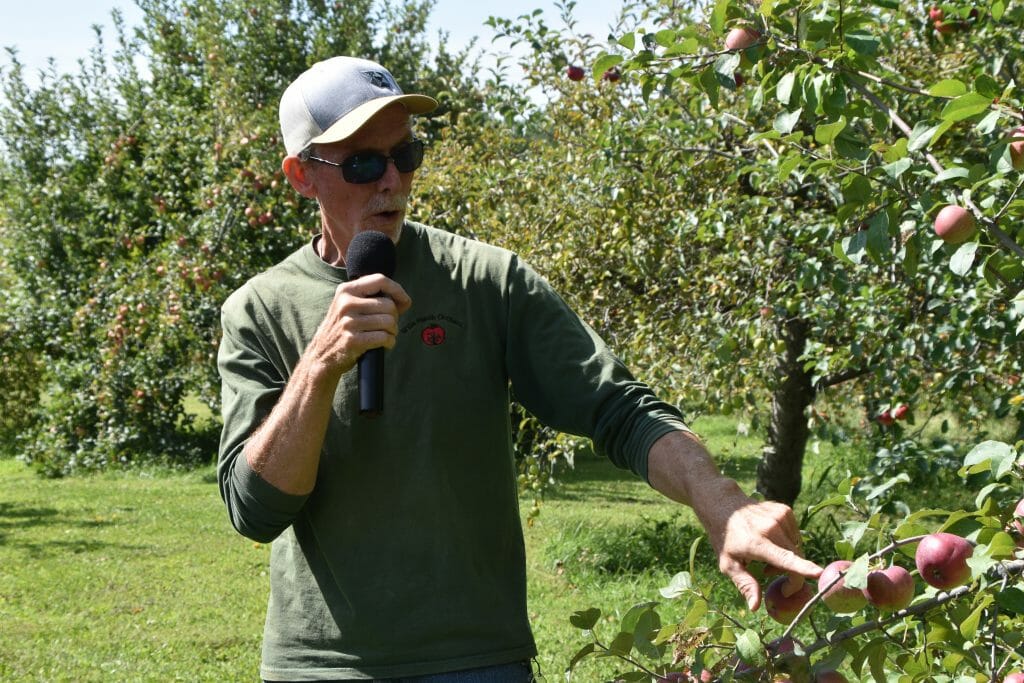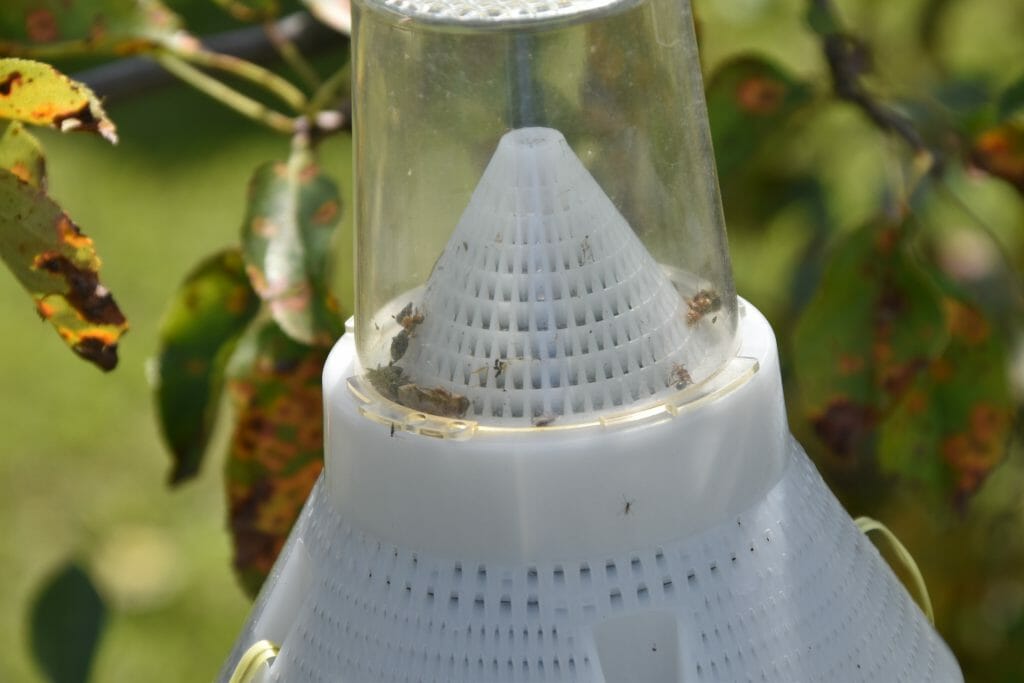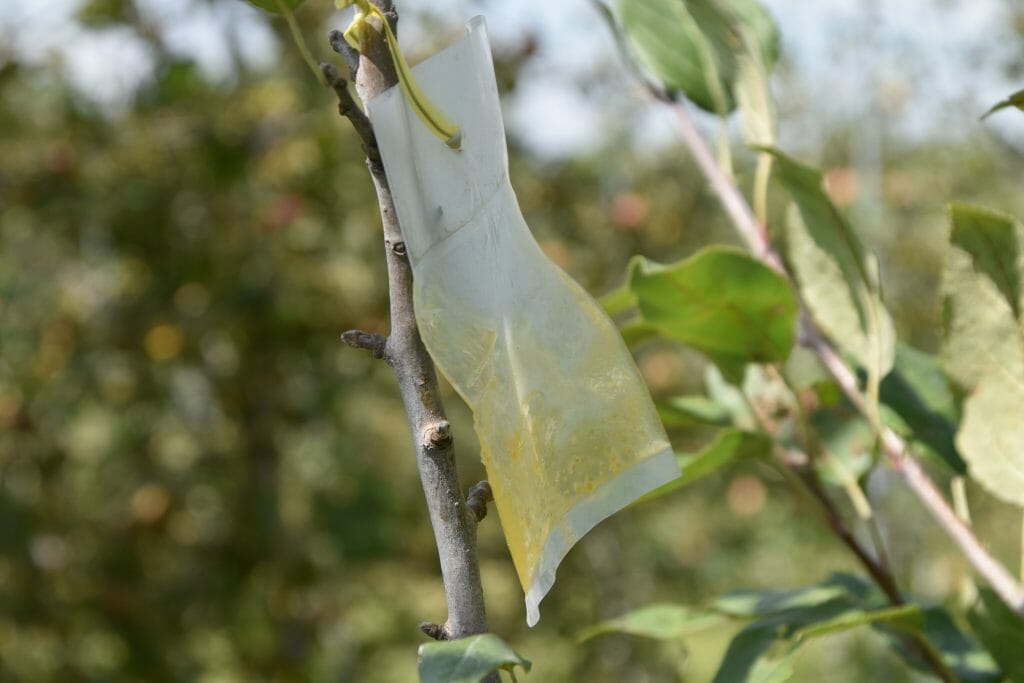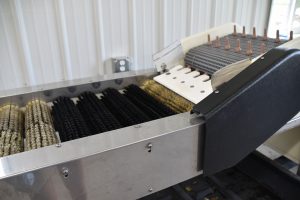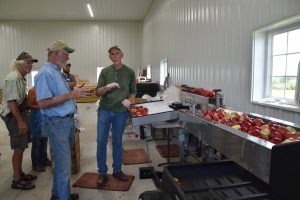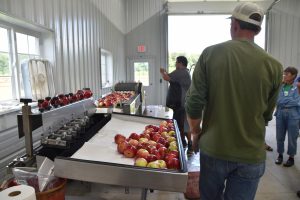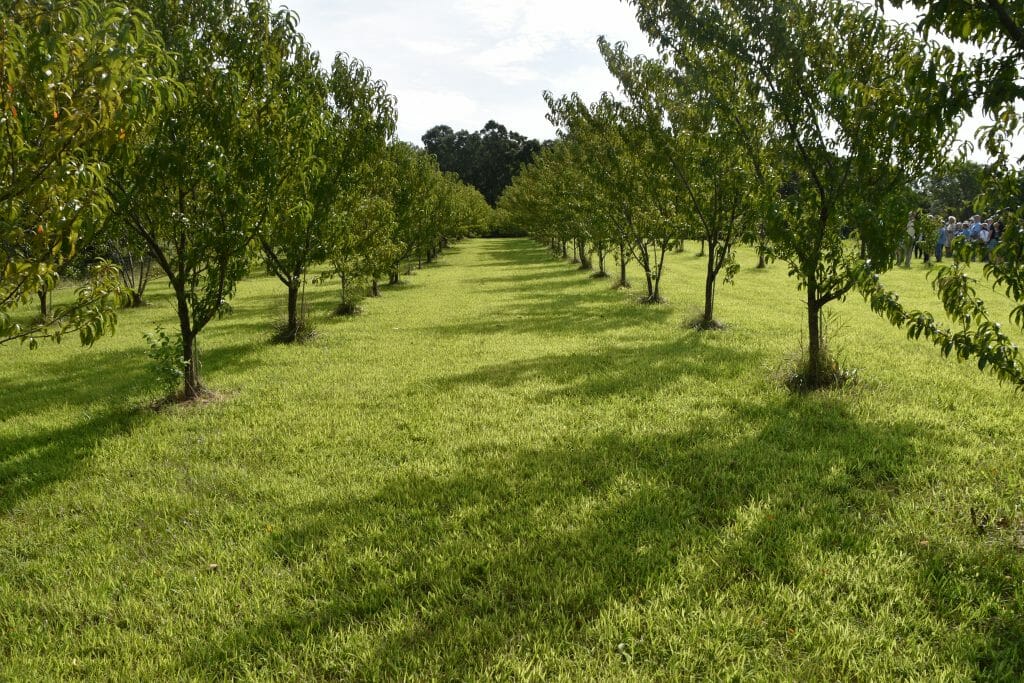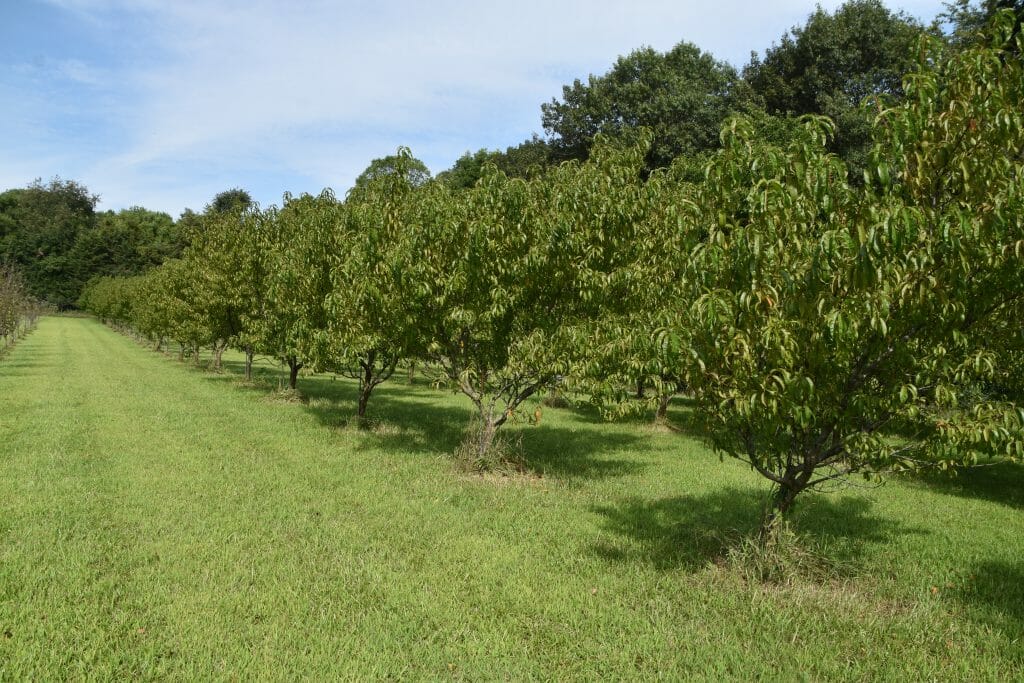Apple Production, Pest Management and Infrastructure at Wilson’s Orchard and Wills Family Orchard
During the summer of 2019, two apple orchards hosted PFI field days, inviting other growers and the interested public to join them in conversation about all things apples (and peaches, and cider), covering topics including rootstock, scion varieties, irrigation, fence, pest and disease management, harvest and packing. Paul Rasch of Wilson’s Orchard and Maury Wills of Wills Family Orchard each have over 20 years of experience growing apples. Both orchards have on-farm sales and some agritourism components for their customers, but both are primarily production orchards. Continue reading below for insights and views of each orchard’s field day.
Paul Rasch – Wilson’s Orchard
Paul grew up on an orchard in Michigan, and at one time managed one of the largest commercial orchards in the country. After taking a 15-year break from apples, he and his wife, Sara Goering, moved to Iowa to purchase and revitalize Wilson’s Orchard and expanded to include a high-density orchard and five acres of cider-specific apples that they press and ferment into hard cider. The orchard business is twinned with Rapid Creek Cidery, which is owned by their daughter Katie Goering and housed in the restored barn at the orchard.
Deer Fence: “If you don’t invest in a deer fence for your orchard, you’re just throwing good money after bad.” Paul uses an 8-foot high, woven wire, high tensile fence. He estimates it costs around $1.30 to $1.50 per foot, if you put it in yourself. On Paul’s fence, the horizontal distance between wires gets smaller as the fence goes down; he wouldn’t choose that style again. The smaller openings toward the bottom of the fence don’t exclude rabbits, but they do exclude coyotes.
Tree Protection: “Spiral guards don’t give you 100% protection, but it does mostly prevent meadow voles and rabbits from girdling all the way around the tree.” Paul noted that people say you should take them off every year, but Paul leaves them on and hasn’t had an issue. They also don’t use any rodent poisons, instead providing coyotes, owls and hawks with habitat and keeping several farm cats.
The new row of trees (pictured above) is the variety Rosalee, a cross of Gold Rush and Honeycrisp from the Midwest Apple Improvement Association. Paul planted these trees 2.5 feet apart, with a tree planter.
Trellis: The trellis was installed following planting. “We’ve taken our trellis up higher with 4-5 wires, and rely on simple clips (pictured below) to hold the trees from moving.” Paul hopes to have newly planted trees reach the top wire by their third leaf (third season after grafting). On dessert apples, Paul expects 150-200 bushels per acre during the tree’s second leaf, and around 800 bushels per acre in the third leaf. Paul noted that orchards in other areas of the country, like Washington state, produce about twice that per acre. But, especially in the cider block, he wants slower growth for high sugars.
Irrigation: Paul’s high-density orchard is on drip irrigation with pressure-compensated, self-cleaning emitters spaced every 40 inches. Though some orchards like Buffalo Ridge Orchard in Central City, keep their drip tape up off the ground, Paul’s is on the ground. The orchard has eight irrigation zones and can run 1-2 zones at a time. Paul sourced his irrigation system from TRICKL-EEZ in Michigan. The frost-free hydrant allows them to gravity-drain their zones, but Paul noted that there is a lot of interesting stuff happening with irrigation materials that reduces the worry with freezing lines.
Varieties and Rootstocks
“In Iowa, our biggest fungus problem is apple scab, so we chose many of our orchard’s varieties because of their immunity to apple scab. The other most important thing I’d recommend about planting is this: Start with good trees — Washington state has the best — and plant them as early in the year as you possibly can.”
“Crimson Crisp is one of the better apples for organic-type operations. It’s almost completely self-thinning. We have them on Bud-9, and they probably could have used a little stronger root. Bud-9 has good disease resistance, and is resistant to fire blight. Ginger Gold is our earliest good eating apple, we put Ginger Gold on Bud-9 here, but I would put it, too, on a more vigorous root. Also, grafting on Bud-9 yourself requires some more expertise. Bud-9 is also not good for water-logged soil — anything in saturated soils for us wilted and died.” Paul also briefly mentioned Liberty, Golden Russet, Roxbury Russet and Jonagold; the full list of varieties Paul grows can be found on the Wilson’s Orchard website.
A lot of the scion varieties Paul likes to grow he can’t find on the rootstock he wants. So a few years ago he and his orchard manager, Kyle, started doing their own grafting onto Geneva rootstock and raising them in a nursery plot, shown in the photo below. Paul really likes Geneva 41 and Geneva 11, which are some of the older Geneva varieties. Under a variety of conditions it’s a solid rootstock, and one of the older ones. Paul did a planting on Geneva-935 that initially looked really good – they reached the top trellis wire on their second leaf. But in 2019 the leaves on those trees began yellowing, which as far as they can figure out is a viral infection on the rootstock. The trees were nice when they came from the nursery, but at that time the nursery wasn’t doing virus indexing, which is now a huge concern for Paul, facing 3,000 trees with an affected rootstock.
Herbicides and Pesticides
Paul says, “There is a movement away from glyphosate in fruit trees because it does seem to have a deleterious effect on apple trees. The most recent herbicide application we did this year was with a generic of Oust.” Paul presented his spray program at the 2019 commercial orcharding short course.
Hard Cider Varieties
Paul has five acres dedicated to apples for cider production, which includes Gold Rush, Dabinett and Yarlington Mill among a dozen varieties. A significant problem with cider-specific, tannic apples is getting consistent quality trees, enough volume of good trees and also getting the variety delivered that was ordered. For example, Paul has Dabinett from two different nurseries that are performing very differently. In addition, one nursery sent 450 Dabinetts; at the first harvest in the third leaf, Paul realized 150 of the trees were actually Buckeye Galas.
Pest and Disease Management
“If you’re going to get into cider apples or varieties that are fire blight susceptible, you better have a good plan to manage it.”
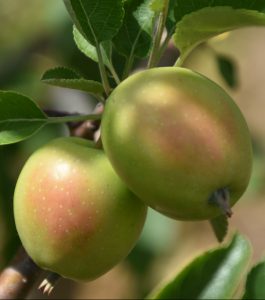 Paul on fire blight: “Cider varieties tend to bloom very late, tend toward biannual bearing and tend to be small apples. Having a large quantity of blooms late in the season is a recipe for fire blight, which is a significant problem for cider varieties in Iowa. We have done a pretty good job of controlling fire blight in our orchard. You first have to understand when you have conditions for fire blight. There is only one good chemical tool for controlling fire blight – streptomycin – and we don’t want to overuse it so that it stops being effective due to resistance. Most of Michigan’s orchards have fire blight that is resistant to streptomycin. When you need to use it, go in full-bore; we also use Regulate as a non-ionic surfactant. The blooms need to be open for awhile to be susceptible to fire blight, but if you watch NEWA, you can better determine when to spray without needing to have your own weather station.”
Paul on fire blight: “Cider varieties tend to bloom very late, tend toward biannual bearing and tend to be small apples. Having a large quantity of blooms late in the season is a recipe for fire blight, which is a significant problem for cider varieties in Iowa. We have done a pretty good job of controlling fire blight in our orchard. You first have to understand when you have conditions for fire blight. There is only one good chemical tool for controlling fire blight – streptomycin – and we don’t want to overuse it so that it stops being effective due to resistance. Most of Michigan’s orchards have fire blight that is resistant to streptomycin. When you need to use it, go in full-bore; we also use Regulate as a non-ionic surfactant. The blooms need to be open for awhile to be susceptible to fire blight, but if you watch NEWA, you can better determine when to spray without needing to have your own weather station.”
“If there’s no bloom and there’s fire blight, you need to have a triage mentality – you might need to get in there and pull the whole tree out, even if it isn’t dead, to get the inoculum out of the orchard. You at least need to remove an infected branch 2-3 feet behind the damage. If you cut too close to the infection, you can easily spread the pathogen on your pruning shears. Pull the tree, cut it way back, or close your eyes and walk away. Anything else will make fire blight in your orchard worse.”
Paul on Japanese beetles: “We tend to not worry about them too much, except on very young trees. Japanese beetles are very variety-specific. Though they can affect the vigor of the tree and the size of the fruit, they also do some thinning for us on a lot of trees, saving us work. We are not dedicated to growing 1,200 bushel per acre, we’re dedicated to growing fruit that tastes great with a minimal spray program. Japanese beetles are hard to kill, you’d have to do some real damage to your beneficial insect population if you want to kill Japanese beetles with insecticides. This year we did put a carboryl on early when their numbers first started coming up because it timed well with our spray for oriental fruit moth, and an early control is the most effective. But plenty of times we’ve left them alone and just taken the chance that building the ecosystem will be better for us in the long run.”
Paul on apple scab: After pruning, Paul flail chops trimmings and grinds them up in the orchard. He also flail chops leaf litter in the fall. He does not burn or spray the trimmings. To control scab on the trees in the spring, he sprays as close to 1/4-inch green as he can, and uses copper sulfate to kill fire blight bacteria and set back scab. He uses Champ, a flowable form of copper.
For more information from Paul, check out these two videos of him presenting at PFI’s orchard short course in 2019:
- Spray Program – Paul Rasch
- Benji Deal, Paul Rasch & Deirdre Birmingham – Hard Cider Production & Management
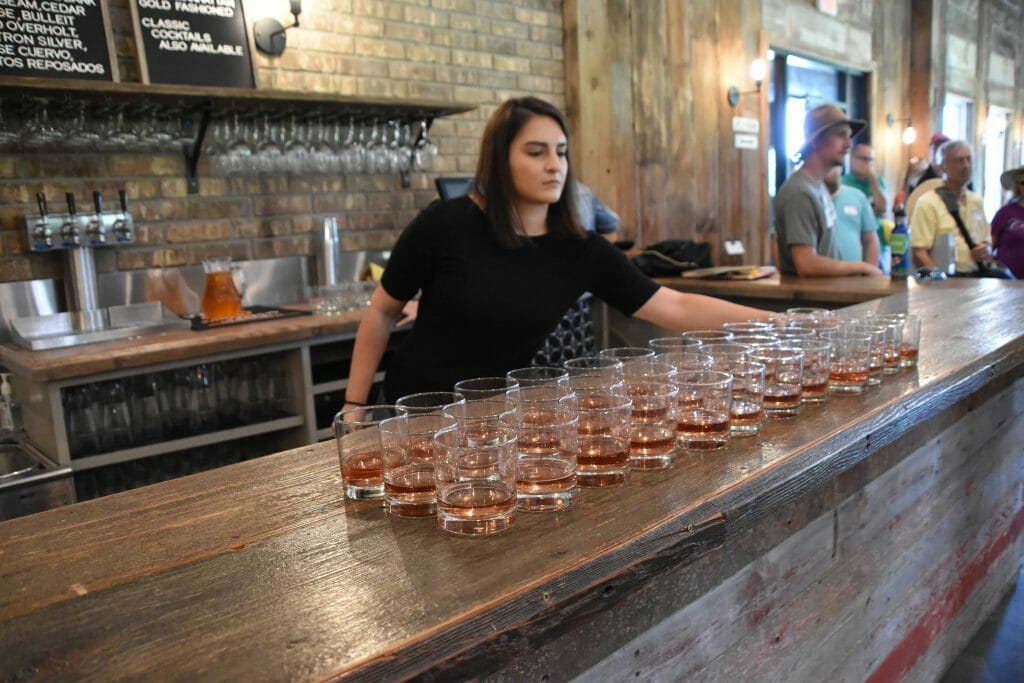
At the end of the field day, attendees sampled Wilson’s Orchard hard cider in the event space at Rapid Creek Cidery. In this photo, Katie Goering serves up hard cider samples.
Maury Wills – Wills Family Orchard
When Maury and Mary Wills bought their property near Adel in 1991, it was 32 acres of open ground — no house, no buildings. Mary grew up on a Guernsey dairy farm and Maury was a city-boy from the south side of Des Moines, but they always knew they wanted to raise their kids on a farm. How would they make it work? Maury became fascinated with organic apple production through the pages of old Mother Earth News magazines. The past nearly 30 years of their lives have been dedicated to building and growing their certified-organic orchard and farm, while raising six children. Maury also works full-time as a bureau director at the Iowa Department of Ag and Land Stewardship. In 2006, the Wills family purchased additional adjacent land, put up a small apple house in 2007 and larger apple handling building in 2017.
The Early Years – Semi-Dwarf
“The first orchard of 100 trees was planted in 1992, and we had to do a lot of replanting after the 1993 flood,” says Paul, “During the first planting we struggled with the tree holes filling with water — it wasn’t well-drained. When we replanted, we hand-dug the 2-foot hole then took an auger — this is labor-intensive crazy — and augered down 2-3 feet and filled it with sand. Essentially it was a French drain, though I didn’t know that at the time. We were just trying to improve the drainage for the tree. We haven’t done this for any of our subsequent plantings because it was too labor intensive.” The first orchard is semi-dwarf apples on M7 rootstock, a few pear trees, sweet cherry (Kristen) and tart cherry (Mount Morenci, Bowington).
“Would we do this differently now? Yes, we would. Semi-dwarf was being recommended by Iowa State at the time, then the industry went in the other direction. We planted these trees 18 feet apart, and planted them around a curve. We thought it looked nice at the time but it’s a little confusing when we’re working in it. It’s really shady in here, and it’s hard to keep these trees tamed down. The day will come before too long where we’ll take these out and replant with something different.”
High Density
“I resisted the idea of high-density for years, but now we’re moving toward it, for a few reasons. It’s easier for organic management, it’s more conducive to a u-pick orchard, and last, I’m not getting any younger and I hate ladders.”
This 2019 planting of dwarf Priscilla and Spartan on Bud-9 (first year, above) is designed primarily for u-pick, so it is not as dense as the high-density. Maury only has the trees supported by conduit; evaluating if it will be enough support. “The dwarf rootstock can’t stand on it’s own — the question is, what can you use in an organic system to hold up a wire trellis? Conduit is allowed because it’s metal, but a thick conduit is expensive. Untreated wood is allowed, but treated wood is not – for me. Some certifiers are allowing treated timber in orchards. The organic program at IDALS — the program I manage — does not allow treated lumber, so I’m not going to use it in my orchard. However, if you started an orchard not being certified and used treated timber and then got certified organic, it would be grandfathered in.”
Apple Varieties for Organic
Because the options for chemical control are limited in organic production, selecting disease-resistant varieties is particularly important. “The early varieties we planted were what were recommended to me at the time as resistant to apple scab: Red Free, Liberty, Enterprise and Gold Rush,” says Maury, “Gold Rush is particularly a good, different-tasting variety, which is also good for hard cider. It’s a late variety, and sometimes we have difficulty with it ripening up. I wouldn’t recommend it north of Highway 30. We took out all of our Honeycrisp, but have recently planted Evercrisp, a cross between Honeycrisp and Fuji — great flavor.”
Maury has considered and trialed a myriad of apple varieties, primarily focusing on resistance to scab and fire blight, which nurserys are good about documenting. Cedar-apple rust is problematic in many parts of Iowa, but because the best nurserys are located in parts of the country without cedar trees, it is hard to know if they will be susceptible. Sometimes Maury tries those varieties anyway. For example, after several years nurturing WineCrisp apple trees, he will probably have to remove 160 of them due to cedar-apple rust damage. They are also very prone to splitting without regular moisture. Snow Sweet he likes; McCowan is good but hard to grow and Maury probably won’t put in any more.
“Pristine is one of the better early apples, but it does bruise easily, so it isn’t very good for taking to market. Freedom — I’m curious how this would do on a dwarfing rootstock. On M7 it is a huge tree, hard to beat back. In the narrow window when it’s ripe — before it’s red — it is fantastic. Dayton can also turn quickly – and turn to mush. Scarlet O’Hara does not get scab, but it has a lot of problems. Don’t grow it.”
Maury sources most of his trees from Adam’s County Nursery.
Pest Management
“We have way more organic tools for disease and pest management than there were 20 years ago. I am convinced we can control coddling moth organically. Plum curculio and cedar-apple rust – I’m not convinced we have a product yet that is effective.”
Deer Fence: Maury now has 30 acres surrounded by deer fence. It was quite a process to get it all done and took several years. For him, electric and 3-D fence aren’t good enough as you begin to scale up. “We can talk about insects a lot, but if you aren’t keeping the deer out, you’re wasting your time worrying about bugs.”
Apple fly: “Our apple fly traps are a round, red object, inside a ziploc baggie, covered in adhesive to sticky-trap the fly. We space them about 20 feet apart through the orchard, and renew the adhesive every year (old bag off, new bag on). You want the trap about eye-level, with plenty of space around it for good visibility. We use kids’ whiffle balls — I used to get used balls from a ball-pit at a pizza place. The fly is attracted to the first red apple-ish thing it sees in the orchard, so when everything else is green, this is red. The eggs of the apple fly become the apple fly maggot.
Coddling moth: “There was a time in the early years when we were getting about 70% coddling moth damage. But so far, we are grading out perfectly this year. Of the 25-30 bushels I’ve been through this summer, I have found only 1 or 2 apples that had coddling moth. The products we use for coddling moth are EnTrust and Sidex. They are very expensive — $300-$400 per quart, and we use 2 ounces per acre.”
Plum curculio: Plum curculio are Maury’s most staunch nemesis. “We have tried everything for plum curculio management — the gallon jugs cut open with the banana peel; the smelly stuff; the goop; the towers with a water basin and oil with the lights above it; we’ve lit fires for insects; put bed sheets out and tapped the limbs. You get to a point with scale that you can’t do all of that, and they’re not quite as effective as you’d hope.”
“Now we are using plum curculio traps — the insects like the dark, like the trunk of a tree. They crawl up the pyramid and then get trapped in the top. I’ve been using a scent above the traps to draw the plum curculio, but I’m not going to do that anymore, I don’t want to draw them and we’ve caught them without having the scent out. A trap will last for five years, and costs $20. Ideally the traps are spaced every 15 feet; I have them spaced a little farther, but add more each year. One female plum curculio lays 400-500 eggs, and she won’t lay them all in one apple. We used mating disruptors this year in the semi-dwarf and high-density orchard; I think they were effective but we need to do more in the high-density.”
“I’m convinced chickens can also help keep the plum curculio down. In the spring we put some feed down under the trees and the chickens follow behind. They can hear the plum curculio falling from the trees.”
“Zestar is a magnet for plum curculio, and is grading out about 60% number 3s. I’m thinking about why Red Free has been 85% number 1s and Zestar is so poor — Zestar is the first to bloom. Plum curculio is attracted to scent. I think Zestar is the first thing going in the spring and the plum curculio is all over it. Eventually I’d like to plant an early-blooming crab apple along the edge of the orchard and see if I can trap most of the plum curculio there.”
Maury on the question of picking up fallen apples: “If there is larvae in the apple, it’s important to get rid of it. But if there isn’t larvae in the apples, it’s not so urgent to pick them up. When we were hand-thinning, I was having the young people put the plum curculio-infested apples in a barrel. At the end of the week, the bottom of the barrel was covered in larva. They don’t stay in the apple for very long. If you’re picking up apples after the larvae have moved out, it isn’t accomplishing your goals for pest management.”
Cedar-apple rust: “We have tried Millstop and copper for cedar-apple rust – neither worked. Oxidate is what I like to use for many fungal and bacterial diseases, but it won’t work for cedar-apple rust.”
For more from Maury on organic pest and disease management, check out the recording of his 2017 farminar.
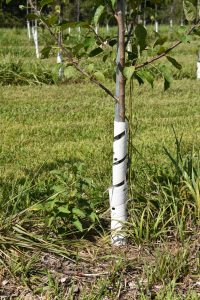
Tree guard on a young tree. On the ground, grass begins to bounce back several weeks after a application of Homeplate.
Under-story management: To keep grass down near young trees, Maury uses an organic herbicide called Homeplate — it knocks the grass back by killing the vegetative portion, but doesn’t kill the grass entirely, just knocks it back. In 2019 Maury used Homeplate three times, but also weed-whacks from time to time. “You can damage your trees with the weed-whacker, so give it to someone with a steady hand.”
“There is no premium for almost organic. I almost wish there was, because it would move more conventional growers toward organic. And if I could spray only one spray for plum curculio or cedar-apple rust, I would save bushels and bushels of apples, and could feed more people. But I can’t do that, because it’s a hard line.”
Apple polishing and sorting line: The apples are rinsed in water with Tsunami, though washing is not a food safety requirement for apples. “We built our cooler and building bigger than what we thought we needed, but now we’d like it even bigger. Similar to the sorting line – when I ordered this I wanted it smaller, but now I wish it was bigger.
Maury on organic peaches: Wills Orchard currently has 100+ peach trees; their varieties are Red Haven, Contender and Veteran, planted in 2011, 12-ft spacing between the trees, 20 feet between the row. They plan to add more. “I know people in Iowa aren’t really planting peach trees, and there’s a reason for it. The peach flower is more hardy during bloom than an apple flower. But during the winter, the apple bud is much more hardy than the peach bud. The apple can go down to -28 or -30 degrees F or colder. With the peach bud, at -15 F you start to worry, at -18 F that’s it for the next year’s crop. We had a really good year two years ago; and we learned how to handle them: harvest at barely a little give – if you wait until they’re ripe, it’s too late. We don’t wash or sort them, only harvest, pack, and let the customer do the rest.”
“Leaf wilt, or leaf curl, is a challenge with organic peaches. Normally you would use a copper spray in the fall – I use a copper product called Queva. Queva is very mild – you really need a stronger product. I would suggest a stronger, approved organic copper product in the fall and then maybe Queva in the spring, when you just barely see green tip. I haven’t yet found a source for the organic-approved copper I’d like to use. The bacterial spot is another issue we face, and we use oxidate for that. With peach trees, if you don’t thin, you’ll have a lot of really little peaches. Some old-timers will beat their trees with foam sticks; we don’t do that because it can damage the tree, but we do thin to get more sizable peaches.”
“Peach trees can grow like weeds, which is kind of a problem because it requires more pruning. They say, with pruning peaches, that you should be able to throw a cow through the tree, or at least a football. So clearly we need to do more pruning on these.”
Maury’s favorite visual of pruning peach trees is this video from UMass Fruit Advisors. He sources his peach trees from Van Well Nursery.

